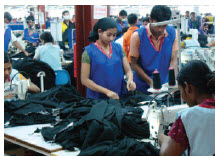
Trade holds the key to development and growth. Moreover, globalization has created significant opportunities for developing countries, while enabling them to increase their earnings through the export of goods and services. Bangladesh is, therefore, one of the countries that has benefited from the comparative advantages of skilled labour and highly competitive entrepreneurship in the textile and garment sector. It is now the second-largest export country in the ready-made garment sector. It holds almost a five-percent share of the current global market.
In the 1980s, a group of young entrepreneurs embarked on manufacturing ready-made garments (RMG) as a profitable product to export, mainly because of the generalized system of preferences (GSP). Under GSP, the facility can export duty-free to the European Union. As a result, Bangladesh has been able to substantially increase its exports.
This sector of the garment industry began to flourish in the 1990s, and has been earning three-quarters of the country’s total export income since the late ’90s, with more than 15 percent growth per year.
The Bangladeshi government has taken many steps to support the private sector in setting up export-oriented industries that facilitated the rise of the labour-intensive RMG sector. The garment industry in Bangladesh consists of approximately 4,000 factories, $19 billion in exports and four million direct employees, mostly women.
Although Bangladesh depends on imported raw materials such as cotton, the production of accessories, such as buttons, zippers, packaging materials and labels has also substantially increased.
Meanwhile, Bangladesh has excelled in manufacturing a wide range of products for global markets. These include, among other things, jute goods, leather products, footwear, ceramics, light engineering products, pharmaceuticals, paper products, electronics, toiletries, furniture, handicrafts, rubber, plastic products, agro-based food products, petroleum byproducts, ocean-going ships and vessels. Bangladesh has been exporting its state-of-the-art pharmaceuticals to the European Union, and has recently made inroads in North America.
Speaking of ships, shipbuilding is now a thriving sector in Bangladesh. The world’s traditional shipbuilders are no longer interested in building small ships, mainly due to high labour costs and low profit margins. This situation has created opportunities for Bangladesh, which has skilled and trained labourers in abundance to build small ocean-going vessels, feeder-vessels (smaller ships that collect and feed containers to larger vessels), coastal passenger ships and ferries. This emerging sector of Bangladesh’s economy has already built ships for a few Western European countries, New Zealand and some African countries. In April 2015, the leading shipbuilder of Bangladesh, Western Marine Shipyard (WMS) signed a contract with Indian business conglomerate Jindal Group to build 10 cargo ships worth US $61.25 million.
Trade relations between Bangladesh and Canada are promising and solid. Canada has accorded duty-free and quota-free access to some Bangladeshi products, including RMG, since 2003, which resulted in a boost of exports from Bangladesh to Canada. Two-way trade amounts to $2 billion yearly. In South Asia, Bangladesh is the second-largest importer of Canadian food grains and other agricultural products, as well as potash. Canada imports ready-made garments, frozen fish, handicrafts, headwear, footwear, furniture and ceramic products from Bangladesh.
Exports from Bangladesh to Canada have grown steadily throughout 2014, and were estimated at $1.27 billion, and imports from Canada were $698 million. Bangladesh is now a country of immense potential for investment as it is offering various competitive incentives (a low-cost workforce, energy, land, a 10-year tax holiday, special economic zones and legal protection for investors.) The country is also encouraging public-private partnerships in infrastructure projects such as highway construction, multi-purpose bridges, power stations, airports and seaports. In these sectors, Canadian companies can take advantage through their engagement as well as investments.
Since the first day of my assignment in Ottawa, trade and investment have been my primary focus, and for this, I have received enormous co-operation from all the relevant quarters. The Canadian government has extended the GPT (general preferential tariff) facility for the apparel sector for the next 10 years, and Canada’s monetary support for the victims of the tragedies in the garment sector has been praiseworthy. In 2013, I witnessed our two countries signing an air services agreement, a positive development for the healthy growth of trade and people-to-people contacts.
While having an agreement on avoidance of double taxation, we await the conclusion of the foreign investment promotion and protection agreement (FIPA) in the near future. Bangladesh also signed a memorandum of understanding with the government of Saskatchewan in 2011 with a view to strengthening co-operation in the fields of trade and commerce, food security, agricultural research, education, bio and clean technologies, human resource development and employment. Finally, more than 100,000 Canadians are of Bangladeshi origin; they are promoting trade and commerce every day.
Kamrul Ahsan is high commissioner for Bangladesh. Reach him at (613) 236-0188.






